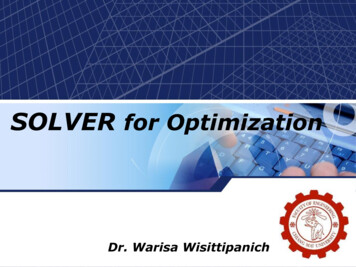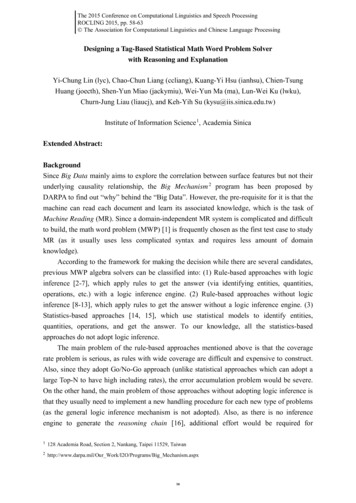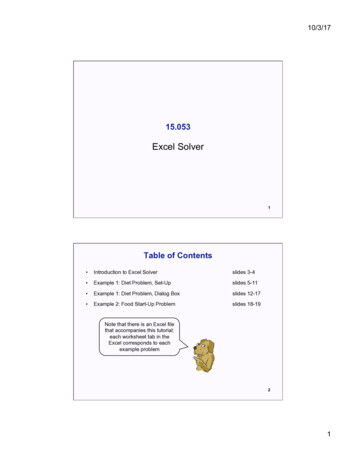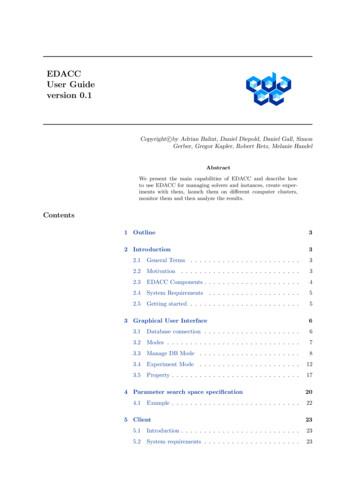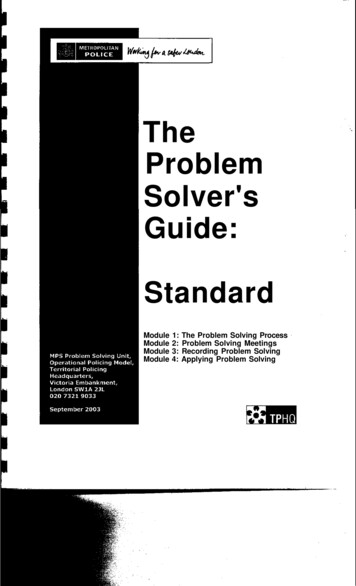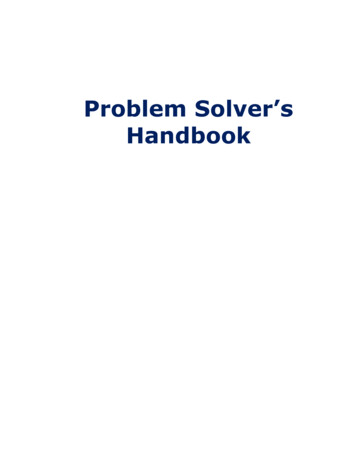
Transcription
Problem Solver’sHandbook
Problem Solver’s HandbookContentsApplication of a Problem Solving ApproachPage 3Problem Solving and ProcessesPage 4Defining a Problem and Common MistakesSetting an AimPages 5 and 6Page 7Research and AnalysisPages 8 and 9Routine Activity and Rational ChoicePage 10Broken WindowsPage 11Situational Crime PreventionPage 12Thinking Creatively and Negotiating ChangesPages 13Acceptance of ResponsibilityPage 14Evaluation and Recognition of OthersPage 15Neighbourhood Policing - EngagementPage 16Community Engagement MethodsPage 17Prioritising the ProblemsPages 18 and 19Environmental Visual AuditsPage 20Working to Resolve the ProblemsPage 21Updating the Community and LeafletsPages 22 and 23Writing a Newsletter and News ArticlePages 24 and 25Assessing a Problem Solving InitiativePages 26 and 27Summary of Problem Solving ProcessesPage 28Copyright InformationThe content of this book is fully protected under the Copyright Laws ofthe British Commonwealth of Nations, the United States of Americaand all countries of the Berne and Universal Copyright Conventions. Allrights are strictly reserved.@Neil Henson Sixth Sense Training Limited 2018www.sixthsensetraining.co.ukPage 2
Problem Solver’s HandbookApplication of a Problem SolvingWithin Policing and Community Safety a Problem Solving approach canbe used for the following:1 Reducing Crime and Disorder.2 Reducing Calls for Service. (Including Road Collisions)3 Neighbourhood Policing.Reducing Crime and DisorderCrime and Disorder problems canbe identified using a StrategicAssessment. The results are usuallygrouped under broad terms such asBurglary or Harm Reduction.These broader terms becomeStrategic Aims which need to beassessed, in order to identify thespecific problems. Key CrimeTheories have been detailed later in the handbook.Reducing Calls for ServiceThere will be certain calls which are either frequent in nature or costlyon resources (officer’s time / money) or both. These will usually havea theme, such as Missing Children, Disorder in a Town Centre orRepeat Callers and would need to be further assessed in order toidentify a precise location or a specific caller.Neighbourhood PolicingThere will be crime and disorder problemswhich may not be a crime priority or rankhighly as a call for service, but would stillhave a detrimental impact on the community.Officers assigned to a specific area wouldengage with the community to identify thespecific problems and work with them usinga problem solving approach.A Community Engagement Process is detailed later in this handbook.www.sixthsensetraining.co.ukPage 3
Problem Solver’s HandbookWhat is Problem Solving?Here is our definition:Problem solving is changing the current situation intosomething better, and keeping it that way. Neil HensonTo help make the change, there arestages that need to be undertaken.These stages form part of a ProblemSolving Process. There are manyProblem Solving Processes. One of thefirst to be used by the Police is calledSARA. www.popcenter.orgAre there alternative ProblemSolving Processes?Yes, a number have been developed over the years. This handbook willbe working through one called PARTNERS, developed by Neil Henson,who has been working in Problem Solving since the 1980s.You will see that it follows the same key stages, but isolates eachstage with more information, to make it easier for the user. Also, themnemonic PARTNERS, reminds people to seek out those who sharetheir problem and get the benefits of working with them.SPProblem and Partner IdentificationAAim SettingARResearch and AnalysisRTThinking CreativelyNNegotiating the ChangesEEvaluationRRecognition and RewardSSharing Good PracticeAwww.sixthsensetraining.co.ukPage 4
Problem Solver’s HandbookWhat is your problem?Defining the problemaccurately is the keystoneof problem solving. Define itincorrectly and all subsequentwork could be aimed ‘at thewrong goalposts’.A well-defined problem canusually be recorded in onesentence, but be preparedfor it to take a long time toget it right.We have found that there areeight common mistakesthat people make whendefining their problems.Here they are:1 Multiple problems5 Not being clear2 Consequences63 Aspirational7 Implied cause4 Too much jargon8 It is just a statementLimited description1. Multiple problems – If you can’t describe your problem in a singlesentence, you’ve probably got more than one problem e.g. Crime inthe Bus Station. You must separate the problems or you’ll besetting aims that cannot be met and your responses will not work.Be specific e.g. Assaults on staff, robbery, criminal damage.2. Consequences – When what you have described are symptoms orthe consequences of the problem, rather than the problem itselfe.g. Injuries from broken bottles, as opposed to sale of alcohol tounder-aged youths resulting in drunk and disorderly behaviour andassaults.www.sixthsensetraining.co.ukPage 5
Problem Solver’s HandbookIf you and your partnership only have the capability to tackle theconsequences, then acknowledge that’s what you’re doing andselect the most applicable response from the Impact Scale.Details of the Impact Scale can be found later in the book.3. Aspirational – Where someone records the aim without definingthe problem e.g. “We want more people to come into the towncentre at night”, as opposed to identifying the reasons why peopledon’t come and defining them as separate problems.4. Too much jargon - The use of acronyms is exclusionary and mostorganisations have their own jargon which means nothing to peoplefrom other organisations. This isn’t an issue until you want toinvolve other partners. Then it can be one of the biggest blocks toworking together and making sense of information. Do you wantto have to employ an interpreter for every meeting? If in doubt,explain an acronym or, even better, get rid of it.5. Not being clear – Clarity is all important if you want people tounderstand the precise nature of the problem. Plain English shouldbe used always. Some people are reluctant readers. Some arepoor readers. Some have English as a 2nd or even 3rd language.Unfortunately, it’s been our experience that, on occasions, somepeople have not understood the problem and not had theconfidence to say so. They then mask this with terminology thatlooks knowledgeable but doesn’t stand up to scrutiny.6. Limited description –This is when just two or three words arewritten and the reader is expected to know exactly what theymean. We are supporters of brevity, but if you write just a coupleof words you make it unnecessarily difficult for others to appreciatethe problem and therefore they cannot help you.7. Implied cause – Where a person has built what they believe to bethe cause into their definition e.g. “We are unable to providetraining opportunities at all of our sites across London as we do nothave an office at each site”. Are you basing your definition on whatyou know or what you believe? The problem is only being examinedwith one possible cause in mind.8. Making a statement – Where what you’ve recorded is astatement rather than a problem e.g. “Cars driving up and downthe sea front at night”. So what? It’s better to isolate specificproblems being caused e.g. “Cars being raced recklessly causingdanger to pedestrians”.www.sixthsensetraining.co.ukPage 6
Problem Solver’s HandbookWorking with othersYou can work on your own but there are somany benefits of working with others, bestdescribed as your partners.BenefitsThey can give you a different perspective,more information on the problem,additional resources and support whennegotiating with others.One way is to ask yourself the question,“Who shares my problem?”You can also find your partners by asking “Who shares my aim?”What is it you want to achieve?This would be your aim. Here is a mnemonic to help set your aim.SSpecificMake sure the Aim “hits the nail on the head”.M MeasurableDecide on effective ways to measure success.AAchievableYour resources will influence this.RRelevantAre your actions working towards your Aim?TTime-boundIt will need a specific end date.Deciding what is achievable can be difficult and hard to express toothers. Fortunately, the following has been written. It is called theImpact Scale* and gives you five choices on what to aim for.1Eliminate the problem2Reduce the problem by degrees3Reduce the seriousness of a problem4Deal with the problem more efficiently5Persuade another body to take the lead*The Impact Scale is based on an idea by Prof John Eck and is used here with hiskind permission. Source: John E Eck and William Spelman (1987)Problem-Solving: Problem-Oriented Policing In Newport News. Washington, DC:Police Executive Research Forum.www.sixthsensetraining.co.ukPage 7
Problem Solver’s HandbookResearching the problemThe first part focuses on our problem andasks specific questions. This is known asconvergent research.What’s going on?Who is involved?When is it happening?Where is it happening?How much is it costing?How long has it been a problem?Did anything change before the problem started?So far, the questions have concerned the effects of the problem itself.An additional approach is to ask ‘opposite’ type questions. Here aresome examples.Who is not affected by the problem?Where is there no problem?When is it not happening?Answers to these questions may provide some ideas on how yourproblem can be resolved.Getting a measure of the problemYou will need to get a ‘a snapshot’ or measure, of the problem beforeany changes have taken place. This is known as a baseline.It can involve quantitative and qualitative measures. Quantitative datainvolves numbers. You can count such measures before and after yourresponse(s), and note the difference. Qualitative data asks foropinions, some based on feelings and impressions.The demand to make a changeAs well as finding out all about the problem you need to know who isbehind the requirement to have something done? The three questionsyou need to ask to establish the demand are:1. Who is asking?2. What is it they want?3. Why is it important to them?If you discover these people have unrealistic expectations of what canbe achieved, they need to be told why it is not possible.www.sixthsensetraining.co.ukPage 8
Problem Solver’s HandbookAnalysis – Making sense of what you’ve foundIt’s about making inferences based upon the Research and honing theinformation down into a usable form and concentrating your efforts onthe information that will be most useful.Why? Why? Why?Firstly, summarise the problem. Then ask the question “Why might theproblem exist?” (Only use might at this stage as we may not know thedefinite reasons, only the possible reasons). Then ask ‘Why?’ againagainst each of the reasons given.StoryboardsTo increase your effectiveness, it helps if you and your partners get anappreciation of the all events which are causing your crime, disorder oranti-social behaviour problems. You can do this by isolating each stageand describing the role played by all those involved.We describe this method as a ‘Storyboard’. A system used in filmmaking to demonstrate a required sequence of events and are madeup of sketches, photographs and film footage. So, we thought, why notuse the same system to present the sequence of the crimes beingcommitted.The very process of completing the stages will identify any gaps inyour knowledge about what is going on and make it easier to clearlytask others to undertake further research to fill the gaps.www.sixthsensetraining.co.ukPage 9
Problem Solver’s HandbookCrime TheoriesThe Problem Analysis TriangleIt shows that all events, problems or incidentshave three components. For crime, they areVictim, Offender and Location. SometimesTime is added and it is described as VOLT.Routine Activity TheoryThis is a theory first developed by thecriminologists Marcus Felsonand Larry Cohen.A likely offenderCrimeA suitabletargetThe absenceof a capableguardianPhysical convergence in time and placeThey argue that when a crime occurs,three things happen at the same timeand in the same space: a suitabletarget is available; there is nocapable guardian to prevent the crimefrom happening; and a likely andmotivated offender is present.A capable guardian is anything - either aperson or thing, which discourages crimefrom taking place. For example: CCTV,police patrols, security guards, fences andlocks.A motivated offender is someone whowants or needs to commit crime. Try tothink like the offender. Why are they committing the crime?Rational Choice TheoryAnother theory that builds upon theRoutine Activity Theory is Marcus Felsonand Ron Clarke’s Rational Choice Theory.It means trying to see the world from theoffender’s perspective: How does theoffender make crime choices? What drivesthem? Why do they pick certain locations,goods or victims?www.sixthsensetraining.co.ukPage 10
Problem Solver’s HandbookBroken Windows TheoryJames Q. Wilson and George Kelling developed the Broken WindowsTheory, which suggests that crime is the almost inevitable result ofdisorder.They suggested that thefollowing sequence of eventscould be expected indeterioratingneighbourhoods:Evidence of decay (brokenwindows, deterioratedbuilding exteriors) remainingin the neighbourhood for areasonably long period oftime.People who live and work inthe area feel more vulnerable and begin to withdraw. They becomeless willing to intervene to maintain public order or to address physicalsigns of deterioration.Sensing this, offenders become bolder and intensify their harassmentand vandalism. Residents become yet more fearful and withdraw evenfurther from community involvement and upkeep.This atmosphere then attracts offenders from outside the area, whosense that it has become a vulnerable and less risky site for crime.www.sixthsensetraining.co.ukPage 11
Problem Solver’s HandbookSituational Crime PreventionIt focuses on reducing the opportunitiesfor criminals to commit crime. Itconcentrates on the criminal and whatthey think about.If they think they can get away with aparticular crime, then make it appearharder, riskier and less rewarding tocommit that crime. It was written byRonald V Clarke.He identified five separate headings.Increase the risksIncrease the effortStrengthen formal surveillanceHarden the targetsAssist natural surveillanceControl the accessUtilise place managersScreen the exitsExtend guardianshipDeflect offendersReduce anonymityControl weaponsReduce the rewardsRemove the targetsDeny benefitsDisrupt the marketConceal the targetIdentify propertyRemove the excusesReduce the provocationSet rulesReduce frustrationsPost instructionsDiscourage imitationAlert conscienceAvoid disputesAssist complianceNeutralise peer pressureControl alcoholReduce emotional arousalwww.sixthsensetraining.co.ukPage 12
Problem Solver’s HandbookThinking CreativelyAs you work through the Problem SolvingProcess you will get to a point where you knowwhat the problem is and you are movingtowards developing options to resolve it.This is the time to have a think about doingsomething creative. Creativity is defined as“Original ideas that have value.”Firstly, assess other’s good practice and seewhether their responses could be employed tosolve your problem. You are likely to have toadapt them to your situation. Making these smaller changes tosomething that already exists is called Incremental creativity. Doingsomething new is called Radical creativity.Realising OpportunitiesHere are four ways we could consider whendeciding how we could change the currentsituation to something better.1Create something new2Increase your capacity3Increase your flexibility4Improve your efficiencyNegotiating the ChangesNow you have gathered your options, you and your partners will needto decide which ones you will use to make the changes needed. Thesechanges can be described as actions.Monitoring is continually assessing whether or not any of yourchanges are working.If the changes are not happening it could be that others who couldassist you are choosing not to do so. This situation is not new to thoseinvolved in problem solving and, as a result, guidance notes have beenproduced on how you can encourage them to accept responsibility.(See next page).www.sixthsensetraining.co.ukPage 13
Problem Solver’s Handbook10 ways to convince others to acceptresponsibility for Problem Solving1. Educate others regardingtheir responsibility forthe problem.2. Make a straightforwardinformal request forothers to assumeresponsibility for theproblem.3. Make a targetedconfrontational forothers request toassume responsibilityfor the problem.4. Engage an existing organisation, that has the capacity to help,to address the problem.5. Press for the creation of a new organisation to assumeresponsibility for the problem.6. Shame the delinquent organisation/ person/ department bycalling public attention to its failure to assume responsibilityfor the problem.7. Withdraw services related to certain aspects of the problem.8. Charge fees for services related to the problem.9. Press for legislation mandating that organisations/ persons/departments take measures to prevent the problem.10 Bring a civil action to compel another organisation/ person/department to accept responsibility for the problem.The above advice has been adapted from a document called: Shifting andSharing Responsibility for Public Safety Problems - Community OrientedPolicing Services by Herman Goldstein and Michael S Scott (2005). – USDepartment of Justice, Office of Community Oriented Policing Services.Response Guide No.3 Available for free download from the Center forProblem Oriented Policing website www.popcenter.orgwww.sixthsensetraining.co.ukPage 14
Problem Solver’s HandbookEvaluationFirstly, Impact Evaluation. Todetermine what happened to theproblem, you need to ask thefollowing questions:Was the Aim met? If not, why not?Did my responses cause the changes?Secondly, Process Evaluation requires you to look at what you’vedone and, regardless of results, to ask what went well and what didn’tgo well and the reasons.Recognising othersIf things improved, then celebrate it! Reward good work. Ensurepeople get the credit they deserve. This is a part of problem solvingthat can get overlooked. If people feel that they have been part ofsomething worthwhile, they will be more inclined to take part again.Sharing good practiceWithin your organisation. Add a section on ‘Sharing Good Practice’into internal staff appraisals on how the person identified and appliedthe good practice.Outside your organisation. Attend a conference and present detailsof your good practice.Further informationA book on problem solving and partnershipworking called “Who Shares your Problem?”has been written by Neil Henson, winner ofthe UK Home Office Tilley Problem SolvingAward.It provides more information on thePARTNERS Problem Solving Process witha number of examples. It is available inKindle and Paperback versions fromAmazon.www.sixthsensetraining.co.ukPage 15
Problem Solver’s HandbookEngaging Communities – Five Stage ProcessStage 1Understand the CommunityTo be efficient in engaging withthe local community it is vitalto find out everything aboutthe people living and workingin your area.This assessment will inform youon how to select the mostsuitable engagement methods.It would make sense to find outif there are other organisations who are currently engaging with yourtarget groups. You could see if you could be part of their programme.How you can divide up your area?In the UK, these are described as Ward, Neighbourhood or OutputArea Summaries. (The Health Service makes use of Output areas)What should be included?It should include: a map; thepopulation statistics and characteristics;services and facilities; housing types;transport; education; corporate andretail businesses: faith centres andlibraries.Also include: Community groups suchas Neighbourhood Watch; Resident andTenant Associations and VoluntaryOrganisations.There are companies that can provideinformation about your area.You could record the results of publicattitude surveys, which identify sites ofAnti Social Behaviour, as well asIntelligence Assessments on crime.www.sixthsensetraining.co.ukPage 16
Problem Solver’s HandbookStage 2Engage with the community andidentify their concerns / problemsOnce you have information about the communities in your area youneed to make contact with them to find out what issues are causingthem most concern. Below are the different levels of engagement.Information GivingPurposeTo provide people with information about your plansand services.Expectation That information will be accurate, balanced and updated as necessary.Information GatheringPurposeTo collect information about attitudes, opinions andpreferences on specific policies and proposals that willassist your understanding and decision making.Expectation That information gathered will be treated and usedresponsibly, that feedback will influence decisions andthat people will be kept informed.Partnership CollaborationPurposeTo establish through consultation and discussion whatthe issues and priorities are and to work together ineffective partnerships to improve services.Expectation That decision making will be shared and someresources will be held in common. That all parties willbe circulated with progress bulletins.www.sixthsensetraining.co.ukPage 17
Problem Solver’s HandbookWays to engage with the communityFirstly, make use of your understanding of your community to identifythe types of people living in your area. For example, they could bepredominantly older people or daily commuters. Select which groupyou are targeting.Secondly, make a decision on what you are trying to achieve fromthe time you have with them. (See the different levels on the previouspage) Do you want to give them information or are you looking todiscuss the priorities for your team?Finally, examine the engagement methods available and apply theones that are most likely to be effective with these people. Forexample, commuters can be best contacted at the train stations.Commonly used engagement methodsKey Individual This is made up of key local people whose viewsNetwork (KIN) can help to establish priorities for policing in theirarea.One of the key activities is to survey their viewsabout local issues of concern and to identifytarget activities for the Neighbourhood Policingteams. There are also ‘on-line’ versions available.SurgeriesThese provide an easy way for people to voiceany concerns. Policing teams organise surgerieswhere people can have a one-to-one conversationwith their local police officer or communitysupport officer about any concerns they have.X marksthe spotThese are similar topostcards but thereis a map of the areaon the card and theperson marks withcrosses the areaswhere they do notfeel safe.www.sixthsensetraining.co.ukPage 18
Problem Solver’s HandbookEnvironmental Visual AuditsAn environmental visual audit (EVA)is away of assessing what an area is like.It can identify the good things in place,but it is generally used to identify thethings in public that are a problem,such as graffiti or fly-tipping.You will need to decide whether it isbetter to have members of thecommunity with you. They will giveyou their perspective of an area, thatyou may not have considered.You could also invite a local councillor to come with you. Not only arethey are going to be a partner, but they may be able to assist youwhen you are trying to make a change. A risk assessment may need tobe undertaken. Here are some other points to consider.LocationConsider the size of location to be covered.TimeWhat is the best time to get an accurateassessment? If checking for drugs paraphernalia, justafter street cleaning would not be a good time.TransportHow to get there and back. If a large area is to becovered, how best can it be done?Method ofA camera the best method, supported by a writtenrecordingrecord. However, individuals should not beinformation photographed as this would require authorisation.Achievabletime limitsCan the EVA be done within a reasonable period oftime? Will splitting an EVA across days affect results?PersonnelHow many people involved? All personnel should begiven a specific task and also given a start and finishtime. Also provide people with a contact number.ContactHow will you all stay in touch? Visual? Radio? Mobile?Everyone should be contactable at all times.How is theDate and time. Precise location. Comments made byinformation people to yourselves as you walk around their area.recorded?Any evidence recorded, such as pictures.www.sixthsensetraining.co.ukPage 19
Problem Solver’s HandbookStage 3Prioritise the problemsYou will reach a point when you have made contact with sufficientmembers of your community and have a good appreciation of theproblems in your area. However, it is not simply a matter of askingpeople what they want and giving it to them. Even if there weresufficient resources to give people everything they wanted, publicpriorities may be contradictory.Therefore, it is about understanding the perspective of the communityand then deciding fairly what can and cannot be worked on. One wayto make these decisions is to hold public meetings to clarify the issuesand select the priorities or have a representative group who thenselect the priorities. This approach has emerged across the UnitedKingdom and, even though the groups have different names andvariations in their approach, they are fundamentally the same. Here isa summary of the main ones.Neighbourhood Action Groups (NAGs)A NAG is a multi-agency, problem-solvinggroup that consists of relevant partneragencies, key stakeholders and membersof the local community.NAGs attract a broad and diversemembership with a variety of skills andexperience. Practical and communicationskills are all highly valued.‘Have your say’ meetingsAt the 'Have your say' meetingpeople tell the NeighbourhoodTeam what issues concern them.Alternatively, some areas offerpeople the facility to registertheir problems and to suggest orvote on the local priorities.After the meeting, a sub group decides how they will work together toresolve the neighbourhood priorities. The Neighbourhood PolicingTeam report back to the next meeting on progress and update theirlocal website.www.sixthsensetraining.co.ukPage 20
Problem Solver’s HandbookPartnership and CommunityTogether (PACT) meetingsPACT meetings are an opportunity for thecommunity to have their say on whatmatters most to them in their area. They provide an accurate pictureof what is really happening locally. The problems encountered arediscussed and solutions explored. From the issues raised at themeeting and those brought to the meeting by the local police theydecide on the PACT priorities.Ward / Neighbourhood PanelsA Panel is made up of local people who live and/or work in the area.They would have been identified through the engagement activitiescarried out in the area. It is important that the group is representativeof the community and has its support.This can be achieved by nominations being made at public meetings orevents. An ideal size for the group would be about twelve people.The Panel negotiates with the Neighbourhoods Policing Teams on thepriorities for the local area by examining the results of communityconsultation and research. It also includes results from public eventswhere the community have voiced concerns. The purpose of thesepanels is to agree a realistic and achievable course of action to addressthe issues raised by the community.What about involving local councillors?The Ward panel may also benefit from the involvement of the localWard Councillors. The role of the councillor is to observe the processand contribute their local knowledge of problems. The Councillorshould abstain from deciding the priorities in order that the delivery ofservices is not seen to be affected by politics.Stage 4Work to resolve the problemsOnce the problems have been identified and prioritised they need to beresolved. Otherwise what was the point of asking people what issueswere causing them concern. In fact, the very process of engaging withthe community will have raised their expectation that something isgoing to be done. The problems identified have invariably been aroundfor a while and so are the ones that are difficult to resolve. Therefore,a problem solving approach is most likely to be needed.www.sixthsensetraining.co.ukPage 21
Problem Solver’s HandbookStage 5Update the communityAt some point, you will want to provide information to the community.It could be information about a future community engagement event,specific crime prevention advice or an update on things that have beendone to resolve a problem. You could create a leaflet, write an articlefor a newspaper, or produce a newsletter. Here is some advice on howto produce them.Guide on writing leafletsSo whyproducea leaflet?A leaflet gives you a chance to draw attention toyour team, cause or event. Furthermore, aspeople can take your leaflet home with them, itmeans they have more time to absorb yourmessage and can keep a visual reminder of it.Indeed, once distributed, the leaflet may end upbeing read by many more people than the personit was handed to, widening its impact still further.What do youwant to sayto the reader?Clearly define your objective in your own mindbefore you start:Are you looking for a response?What action or attitude do you hope to influence?Are you providing information?You may be doing one, or several of these things.But which is the most important? Sort out yourpriorities before you begin to write or yourmessage will be muddled and the reader will getconfused.Who is it for?Your audience will determine (1) the tone of yourleaflet, (2) the kinds of arguments used, and (3)any action requested.You should have information on how large theaudience is, where they are located and someidea of their needs, attitudes and preferences.The contentThe mess
Problem Solver's Handbook www.sixthsensetraining.co.uk Page 5 What is your problem? Defining the problem accurately is the keystone of problem solving. Define it incorrectly and all subsequent work could be aimed 'at the wrong goalposts'. A well-defined problem can usually be recorded in one sentence, but be prepared
